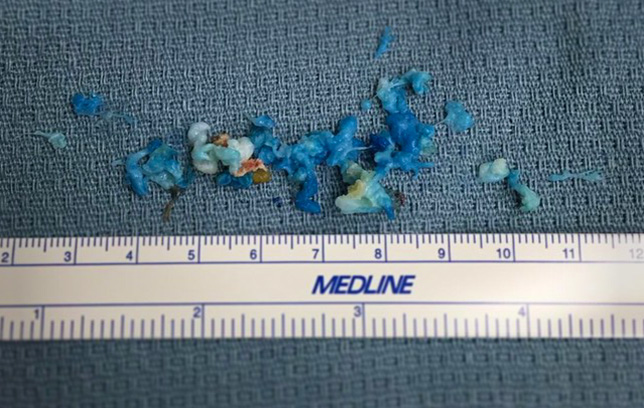
The entire Men’s Health office cringed when they saw Bode Miller’s recent Instagram pic (shown above).
The caption on Miller’s post: "This is what they took out of my back. The doctor wouldn’t let me eat it. Looked like nerds.”
We all thought the photo of blue gunk was grotesquely fascinating. And ultimately, we had one question: What is that stuff?
So we called up Dr. Stu McGill, a professor of spine biomechanics at the University of Waterloo, and as his title suggests, one of the world’s foremost experts on the human spine. "It’s definitely curious stuff," he says. "And I have to tell you, that’s an unusual amount of it."
“It’s the result of a herniated disk, caused by bending your spine under load,” says McGill. "That material has the consistency of crabmeat -- hard, gristly, rubbery crabmeat."
McGill says that your spine’s vertebral disks are made up of two parts: Collagen fibers that are arranged in rings to form the outside of the disk, and a gel-like inner core. “Repeatedly bending your spine under load can cause those fibers to loosen and delaminate from one another, creating an opening. If repeated often enough, the inner-gel squirts out into the space for your spinal cord,” he says. “The gel is then attacked by your immune system, which turns it into that crabmeat-like substance."

A lump of foreign crabmeat sitting on your spine can cause all sorts of issues, says McGill. For example: "It presses the nerve roots causing back pain."
If you’re lucky, your body will slowly digest the extruded crabmeat, solving your problem. But sometimes your body doesn’t do that -- in these cases, your immune system simply walls it off. And when this happens, the substance might have to be surgically removed.
Waiting to see if your immune system takes care of the problem can be a lengthy proposal, so athletes often just have the crabmeat surgically removed, says McGill. That way they can theoretically get back to their sport quicker. (In case you’re wondering, the disk itself can remain in place and functional after this delamination. You just need the right exercises that avoid the injury mechanism to for better recovery. To learn more, check out Ultimate Back Fitness and Performance, McGill’s book.)
Which brings us back to Miller. To be more aerodynamic, skiers bend over when they bomb downhill. “Hitting bumps and banking turns at 90-plus miles an hour in a flexed position is really a perfect storm for getting a vertebral disk to delaminate,” says McGill. It’s also the price of the podium.
If you’re wondering why Miller’s crabmeat is blue, it doesn’t come out like that naturally. “The medical staff dyed it for some reason,” says McGill.
Is this dreaded debris lurking in your back? If you have chronic back pain, then it’s possible.
And of course, you can avoid the problem by avoiding the damage that leads to a herniated a disk. McGill says one key prevention strategy is to not flex (round) your lower back under heavy loads. For the average guy, that means you definitely need to make sure your squat and deadlift form are perfect -- otherwise, you put yourself at high risk for a back filled with crabmeat.
Watch these videos for tips on how to master the squat and deadlift.
More Men's Health:
-- Blast Muscles And Lungs With These Sinister Supersets
-- Simple Trick For Hotter Sex
-- Jen Selter ... You Love Her Butt -- But Should You Listen to Her Fitness Advice?
-- Best Shoes For Every Workout





